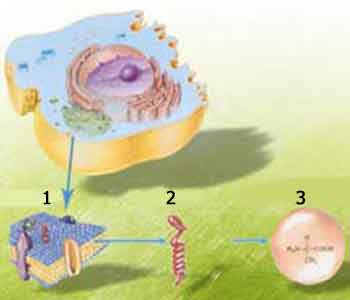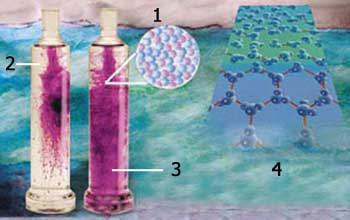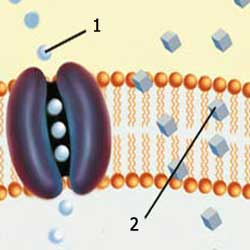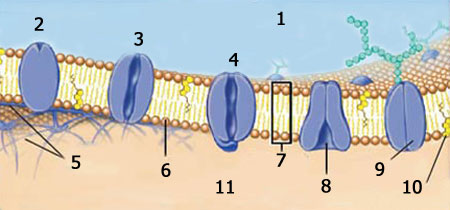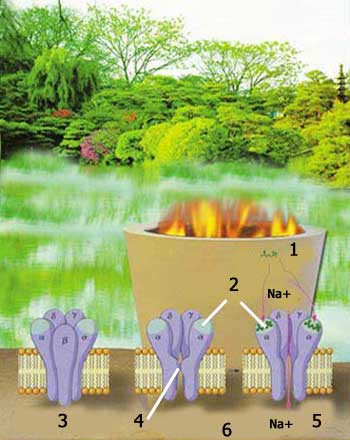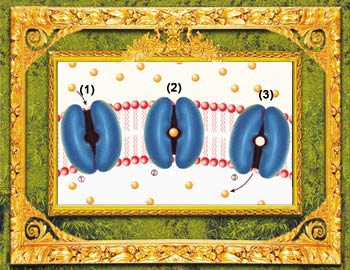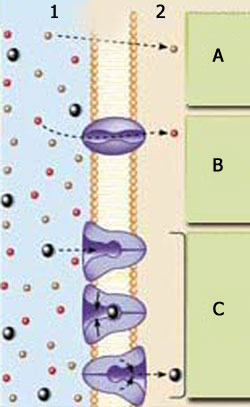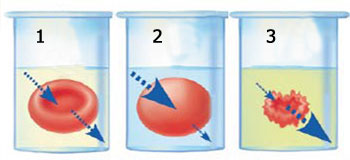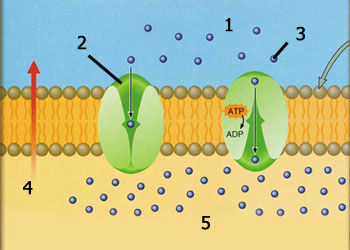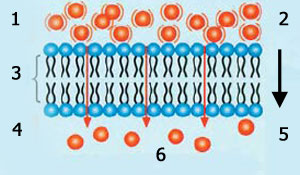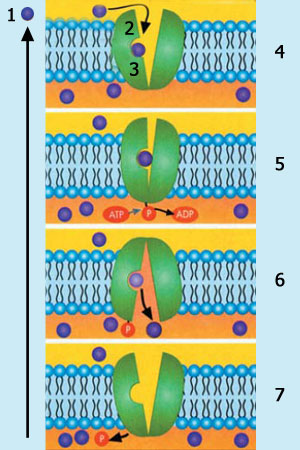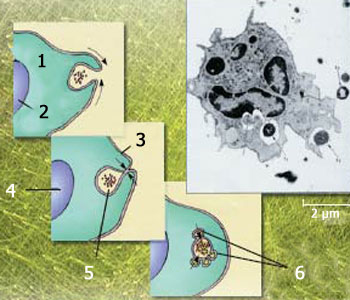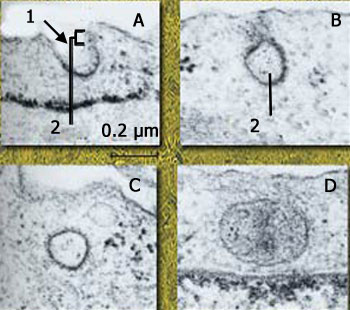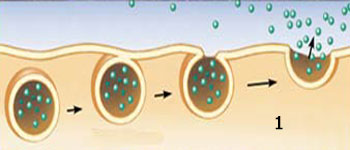Bigotry: The Dark Danger
The Miracle in the Cell Membrane

DOWNLOAD THE BOOK
CHAPTERS OF THE BOOK
- Foreword
- Introduction: The Consciousness Beyond Matter and The Col Lapse of Mechanism
- The Miniature Factories Comprising Our Bodies: The Cells
- The Cell's Complex Structure Can not Be Explained in Terms of Coincidence
- Superior Creation in The Structure of The Cell Membrane
- Complex Transportation Systems in The Cell Membrane
- The Selective Permeability of The Protein Channels in The Cell Membrane
- Selectivity in Nerve Cells
- Signal Selection in Traffic of Data Among Cells
- Selection in The Immune System's Cells
- Vital Selections in The Blood
- The Importance of The Creation in The Cell Membrane in Terms of Multi-Cellularity
- The Delicate Balance in Substances Selected in The Body
- The Cell Membrane Invalidates Claims of The Theory of Evolution
- Conclusion: Allah Pervades Everywhere With His Wisdom
< <
6 / total: 15
Complex Transportation Systems in The Cell MembraneNo substance that enters the bloodstream for any reason can enter the cell as soon as it reaches the cell membrane. It is met in different ways, depending on its size, its chemical properties, and whether it is beneficial or harmful. Before it enters the cell, any substance is subjected to strict checks, just as at the customs at a country's borders. If it is decided that a foreign substance poses a threat, it is not granted admittance. Depending on their identity, however, the entry and departure of some substances has been facilitated, just as with citizens returning to their home countries. These substances can enter and leave the cell with ease, without being subjected to security checks. Some substances even enjoy a special right of entry, like citizens bearing special passports. In short, various measures are imposed on substances entering the cell membrane.
In order for a substance to pass through the cell membrane—to combine with the substance of the membrane—, it needs to be fat-soluble. No matter how hard you try, you can never mix liquefied fat with water. In the same way, any substance that cannot be dissolved in fat can never mix with the cell membrane. To permit substances insoluble in fat to pass through, a special method is employed, and proteins in the cell membrane play a role in that passage. In this way, many substances insoluble in fat are taken inside the cell.
Because of their size, some molecules are unable to pass through the cell membrane on their own. In that event, channel proteins and transport proteins assist the molecules and ions they have allowed to pass through the membrane and enter the cell. Which substances the cell membrane proteins will carry is already determined, and these proteins select these substances with great care. For example, the system that transports sugar does not carry amino acids. The carrying protein distinguishes the two molecules by their shape and number of atoms. For example, if two molecules have the same number of atoms and chemical groups, but one has the smallest geometrical difference, then the carrying system will recognize this and refuse to carry it. 34 But how can a protein know the chemical formula of another molecule and distinguish it by the number of its atoms? How can a protein devoid of intellect and consciousness assume this responsibility, which will benefit the cell? As the result of blind coincidence, it's of course impossible for these proteins themselves to recognize molecules of use to the cell, to assume the task of carrying these into the cell, or to fulfill these responsibilities. Anyone with an open mind and conscience will appreciate how Allah manifests His might and infinite knowledge in all these details. Due to the special bilayer lipid of the cell membrane, the liquids inside and outside the cell do not mix. In the fluid outside the cell, sodium levels are high and potassium levels low. The exact reverse is true of the fluid inside the cell. Similarly, although there are many chloride ions in the extracellular fluid, there are few in the intracellular fluid. In the intracellular fluid, moreover, there is a strikingly heavier concentration of phosphates and proteins than in fluid outside the cell. Many differences like these are of great importance to the life of the cell. All these balances help shape the carrying mechanism in the cell membrane. The exchange of substances through the cell membrane takes place in two main ways, depending on whether the cell uses energy or not: 1.Passive TransportThe cell membrane is the first obstacle a substance encounters upon entering the cell. If the cell expends no energy in the carrying of the substance in question, this is known as passive transport, a form of carriage that takes place with movement from a very concentrated environment to a less concentrated one. The main forms of this transport are diffusion and osmosis. Diffusion
The dissemination of molecules from a denser environment towards a less dense one is generally referred to as diffusion. In cellular diffusion, this means the passage of molecules through spaces between the cell membrane's molecules or else the movement of molecules bound to a carrying protein. Molecules move in various directions from the environment they are already in. This movement changes according to whether the molecule is a solid, a liquid or a gas. Gas molecules are more active than ones in the liquid or solid state. Above the freezing point of their particular substance, molecules are in a state of motion and transfer their momentum forces when they strike another object. For that reason, when you drop ink into pure water, both the water and the ink become less concentrated. The cause of dilution is diffusion, because any molecule in motion tends to push out, spreading as far as it can. As molecules move apart, they become less concentrated, more dilute, more diffuse. 35 In bodily fluids, all molecules and ions are in a state of motion, and every second, these molecules make billions of bounds in various directions. Simple Diffusion
Simple diffusion means the passage of molecules or ions between molecules in the cell membrane, or without being bound to a carrying protein, moving by means of kinetic energy. Water, urea and water-soluble substances pass through these spaces. While strict checks are performed for a great many substances, water is taken into the cell without being subjected to checks. Because water is of vital importance to the body, it must constantly enter and leave the cells. This therefore takes place with no obstacles and with no expenditure of energy. Though water is almost completely insoluble in cell membrane fats, it can easily enter by means of protein channels in the membrane. The speed at which these molecules pass through the cell membrane is astonishing. If energy were needed for water to enter and leave, as it is for a great many other substances, then our bodies' energy levels would be insufficient to meet that need. For example, the total amount of water that passes through the cell membrane of just one of the 25 trillion red blood cells, or erythrocytes, in the blood in both directions a second is about 100 times the volume of erythrocyte.36 If we multiply this coming and going by all the cells in the body, and multiply this by minutes, days and years, we'd be hard put to express in numerical terms the amount of energy a human would require in a lifetime.
But why is it only water allowed such problem-free passage? The entry and departure of other substances is so strictly controlled, but no need is felt to control the passage of water, which is of such vital importance? No doubt there is a perfect selection mechanism in the cell membrane: Molecules make very intelligent decisions for the cell to remain alive and implement them with the greatest attention. At every moment, in every cell in your body, water is carried at great speed through the cell membranes in order for you to remain alive, yet you are unaware of all this taking place. Imagine that for one moment, the control of this entry and exit of water to and from the cells was placed in your conscious control. Though you know water's vital importance, you could not do this for a single moment, let alone for a lifetime. In addition, the way that water enters and leaves the cells is just one of the countless processes in your body. The superior Intellect that operates constantly in the billions of details in the body belongs to Allah, Who created us out of nothing. The process of the taking of water into the cell—just one of the countless systems that need to operate inside the body—is just one of the millions of details that remind us of our need for our Lord. In contrast, substances such as oxygen (O2), carbon dioxide (CO2), nitrogen and alcohol are highly soluble in fat. Thus these substances can all easily pass through the cell membrane's fatty layer without expending any energy. If the entry and exit of the oxygen which needs to be taken in at every moment—and of the carbon dioxide that constantly needs to be expelled—required energy, as is the case with such substances as sodium ions (Na+) and potassium ions (K+), then we would need an amount of energy difficult to express in numbers. In fact, however, large quantities of oxygen enter the cell as if no membrane were there. The way substances that the cell needs in large quantities can enter without any energy expenditure is just one of the signs of Allah's compassion for us. The speed at which substances enter the cell is influenced by the speed of motion of these substances' molecules and the number of spaces in the membrane. At times of urgent need, however, the body is able to accelerate that absorption by secreting a special hormone that widens the gaps between the cell molecules, taking in as much water and expelling as much urea as is needed.
In cases of urgent need, sodium (Na+) and potassium (K+) ions, which enter the cell by the expenditure of energy under typical conditions, can be taken into the cell by means of a facilitated passage. For example, when you accidentally burn your hand, rapid communication takes place between the nerve cells. A substance called acetylcholine is secreted, and a negatively charged channel 0.6 nanometers in diameter opens in the cell membrane. In this way, large molecules and positively charged ions can easily enter and leave the cell. As the doorway outside the cell opens, sodium enters, and as the doorway inside the cell opens, potassium exits, waiting in the intercellular fluid until taken in. Thus the warning signal is transmitted from one cell to another. The signal that goes to the brain when you touch something hot returns by the same route, and you pull your hand back in that same second. 37 What injury would your hand suffer if you pulled it back after a few seconds' delay? Yet in exceptional situations Allah has included precautions to be taken in all parts of the body. By Allah's leave, the cells flawlessly carry out the functions entrusted to them that require intellect, foresight and consciousness, with no confusion ever arising. Yet you are completely unaware of what is taking place.
Facilitated diffusion:In this manner of transport, proteins play a role in the passage of molecules or ions. Facilitated diffusion also refers to diffusion by means of transporters. The transport protein binds to the molecule or ion chemically and thus enables it to pass through the cell membrane. Once bound to the substance to be transported, the transport molecule changes shape. The end of the cell channel that is closed on the inside opens up, and the molecule enters from there. When it reaches a site close to the inside of the cell, the protein splits away from the molecule with thermal motion,—stemming from heat—because the molecule is bound to it only weakly, and thus the molecule enters the cell.
Under this mechanism, the speed at which the molecules are transported is as great as the alteration in the shape of the transport protein molecule. By this method, the substance being transported can pass in both directions. Glucose and most amino acids pass through the membrane by means of facilitated diffusion. 38
OsmosisWater diffusion is known as osmosis—the passage of liquid molecules through the semi-permeable membrane from a denser environment to a less concentrated one. In living things, the closed environment is the cytoplasm, containing such substances as organic acids, sugars, and organic and inorganic salts, bounded by the cell membrane. Passage between the two environments takes place according to the difference in density between the cytoplasm and the external environment, and this passage continues until fluid concentration reaches equilibrium.
Water molecules pass through the cell membrane in large quantities by means of simple diffusion. The constant flow through the cell membrane is very important for the body—for example, in the secretion of and absorption of water in your small intestine.39 In addition, water regularly flows in both directions through the red blood cell's membrane. The level of water flowing in both directions has been very carefully regulated, so that the amounts of water entering and leaving are equal. Thus the cell's volume remains the same. Under some conditions, however, a difference forms in concentration between the two sides of the membrane, and the cell either swells or shrinks, depending on the direction of the water's movement.
For example, if there is a large protein molecule inside a cell, the inward flow of water will be faster than the speed at which it exits, and the cell will expand. The cell membrane behaves like a balloon: If too much water enters the cell, its membrane may rupture split, in such a way as to lead to the cell's death. For that reason, cells have been created with a mechanism that prevents too much water from entering the cell, or too much being pumped out. As a result of this mechanism, a sound external shell that will not split remains around the cell. When starch or other large molecule lies right outside of the cell, the cell then loses water faster than it's absorbed, and the cell shrinks. In that case a need for water arises, due to chemical reactions that take place inside that keep it alive.40 As you see, there is a delicate equilibrium in water's entry and departure from the cell—a system functions that flawlessly by the compassion of Allah—, without any need for supervision from us. 2. Active Transport
Substances also enter the cell membrane by other methods. If a substance passes through the membrane with an expenditure of energy, this is known as active transport, wherein a substance is carried from a less dense environment to a denser one. The energy required is met by ATP, the cellular energy molecule given off with respiration. Energy is needed for glucose, some amino acids, and sodium (Na+) and potassium (K+) ions to be transported into and out of the cell. These passages take place with the help of enzymes in the membrane, and along with the kinetic energy stemming from the motion in this carriage, additional energy is needed. In diffusion, as already stated, the substance behaves according to the prevailing density. However, if a substance is to move from a lower density to a higher one, then energy is expended and active transport takes place. Passive transport may be compared to how water flows downhill under the effect of gravity. Active transport, on the other hand, may be thought of as water being carried up a hill against the force of gravity, by the expenditure of energy. Similarly, someone carrying a load upstairs or drawing water from a well requires energy. In this form of passage through the cell membrane, therefore, requires energy together with enzymes. Active transport is required for sodium, potassium, calcium, carbon, iron, nitrogen, urate ions, various amino acids and sugars. Inside the cell, there must be considerable levels of potassium (K+), magnesium (Mg++), phosphate and sulfur for all kinds of functions to take place in our internal and external organs, for certain control mechanisms inside the cell to operate, and to enable cell reactions. At the same time, there must be high levels of sodium (Na+), calcium (Ca++) and bicarbonate in the outer part of the cell.
If these substances entered and left through the cell membrane, not by active transport but in the easy way, involving no energy expenditure—as water, urea, oxygen and carbon dioxide do—what would happen? In that event the ions inside and outside the cell would be equal. You could do nothing with your muscles because they would not contract. You could not taste the food that entered your mouth, nor secrete saliva. Nor could you send food to your stomach by contracting your esophagus, nor would there be hydrochloric acid in your stomach to digest it. Foodstuffs would not pass through the duodenum to the intestine. The pancreas would not secrete enzymes. It would be impossible for you to absorb nutrients into your bloodstream. Blood pressure could not be regulated, blood could not be pumped and your brain would not function. In short, none of your bodily functions could be performed. The way that all your organs can perform their functions depends on this order at the cellular level. 41
As you see from these examples—and many more could be cited—it is impossible for atoms to think up such detailed plans by themselves. The fat and protein molecules constituting the cell membrane do not realize that there need to be high levels of sodium and potassium ions within the cell. That being so, who tells them that the passage of these substances must be restricted? How can they regulate this vital balance, with no error being made? These questions once again lead us to Allah's creative artistry and knowledge. This flawless system, possessed by every one of your body's trillions of cells, has been created by Allah, the Omniscient.
Endocytosis: The Transport of Large Molecules into the CellIn order for a cell to survive and grow, it needs to take into itself liquid, nutrients and certain substances from its surroundings. In order for large particles to be taken inside the cell, a special method known as endocytosis is employed. The principal forms of this method are phagocytosis and pinocytosis. - Phagocytosis:In this way, bacteria, viruses and particles that will result in damage to the cell or tissue are taken into the cell. The substances taken in are ones that can do harm to the cell or tissues are taken inside the cell, where they are dismantled by substances known as lysosomes. After useful components have been absorbed into the cell, the remaining substances are expelled from the cell and readied for disposal by the excretory system. For example, if you strike a part of your arm against something hard, the bruise will turn purple, and dead cells in that region are taken up and disposed of by this method. Or when you catch an infection, cells absorb the microbes and destroy them. For that reason, phagocytosis is one of the major techniques employed by the immune system, providing swift and generally certain defense against infections.
Only specific cells can perform phagocytosis, the most important of them being tissue macrophages and some leucocytes. Macrophages, known as the defense system's clean-up cells, literally destroy enemies by swallowing them. Despite their small size (10 to 15 micrometers), macrophages also possess the ability to ingest and digest large molecules.
Macrophages can aim at a number of targets at once, like a machinegun spraying bullets, and can destroy a number of enemies at the same time. Antibodies, on the other hand, are weapons that aim at a single target, with protein structures produced specifically for foreign cells entering the body. The surface of a bacterium becomes covered with antibodies "tailor made" for itself. These antibodies are bound to receptors on the phagocyte, which pulls in the bacterium. At the connection point, the phagocyte's membrane collapses in on itself in less than a second and completely enfolds the particle. Increasingly, a greater number of receptors are bound. All these events take place similar to a zipper's being done up. As the membrane closes, it literally forms a pocket. Then, proteins in the internal cell fluid contract and pull the pocket into the cell, after it is left free inside the cell.
How did the phagocyte cells come to assume the responsibility of combating harmful substances, while almost all cells draw both necessary and useful substances into themselves? How did they arrive at implementing this process, known as phagocytosis, in contrast to other cells? How did they develop the lysosomes that fragment within the cells the substances they have swallowed? How does this fragmenting substance—the lysosome—know that it must destroy harmful bodies and not the cell itself? Who decides that a body is harmful, and how? In short, how did the cell acquire the knowledge with which to identify and destroy enemies? As you watch a bruise or infection in your body heal without your doing anything, your cells protect you from danger with exceedingly rational methods. It is not possible for them to have assumed such an important responsibility on their own and then to implement it with such great expertise. No rational person can maintain that these cells possess consciousness and reason. This miraculous Creation we are looking at belongs to Allah, Who created us out of nothing. Allah created every single cell and taught them all their duties. As a result of this perfectly functioning system, every cell performs the task allotted to it. - Pinocytosis is one of the methods employed to transport into the cell substances too large to pass directly through the cell membrane. By this method, large molecules outside the cell are taken inside the cell within small sacs. These large proteins that touch the cell membrane initiate a reaction and cause a change in the cell's surface tension so that the cell membrane folds inwards to enfold the protein. That part of the membrane connected to the sac separates from the membrane and attaches to the cytoplasm. Thus useful substances unable to enter the cell by simple transport are absorbed into it. Let us now consider this process in rather more detail. In order for large molecules to enter the cell, they bind to a special receptor on the surface of the membrane. These receptors surround the exterior of the membrane and become concentrated around the indentation-like sacs. When protein molecules attach to the receptors, the surface of the cell membrane changes in such a way as to cause the sac to collapse in toward the interior of the cell. Fibrous and shrinkable proteins form a net on the part of these sacs facing the cell, allowing the proteins binding to the receptor to be enfolded. Immediately thereafter, that part of the membrane taken within the cell separates from the cell's surface and in the form of a capsule, joins the cell cytoplasm. During this process, calcium ions need to be present in the extracellular fluid because calcium allows the proteins, which permit the capsule to separate from the cell membrane, to shrink.
Pinocytosis can be observed constantly in most cell membranes, although in certain cells it may take place very rapidly. In macrophages, for instance, a total of 3% of the cell membrane may be taken into the cell in the form of sacs in the space of one minute. These sacs used during pinocytosis are very small, their diameters generally vary between 100 and 200 nanometers. For that reason, they are visible only under an electron microscope. Immediately after these sacs are formed inside the cells, by either method, phagocytosis and pinocytosis, one or more lysosomes combine with the sac and transfer into the sac various enzymes inside themselves. In this way, a digestive sac is formed inside which substances are broken down. As a result of the digestive process, small molecules are formed such as amino acid, glucose and phosphate, which are disseminated into the intracellular fluid. Lysosomes may therefore be called the cell's digestive organs. Pinocytosis is the chief method by which very large molecules can enter the cell. Most proteins, for instance, enter in this way. However, how the necessary changes come about for the cell membrane to assume the form of such a sac is still a mystery. All the methods by which useful substances are brought inside the cell have been flawlessly created. But how did this special method come into being, permitting large molecules that cannot be absorbed by any other means to enter the cell? How do large molecules know that they must bind to receptors that will bring them inside? How do receptors in the cell membrane recognize the large molecules that need to be absorbed? This is not something that can be explained in terms of coincidences. Never forget, the perfect behavior being described is effected by molecules formed by the joining together of unconscious atoms. It is definitely impossible for these stages, each of which requires foresight and coordination, to have been achieved by unconscious molecules. Clearly, no system could have come into being as the result of decisions by atoms devoid of intellect and consciousness. This process, which occurs in the delicate membrane of every one of the trillions of cells in your body, manifests the fact of Creation. Humans have lived for ages without any knowledge of this perfect system. These facts, which were discovered only in the 20th century, are only some of the proofs of the existence of our Almighty Lord, the Creator of humanity. Exocytosis: The Expulsion of Large Moleculesfrom the Cell
Exocytosis is the name given to the expulsion of substances too large to pass through the cell membrane. During exocytosis, the cell takes whatever is to be expelled into a sac and transports it to the surface of the membrane. The sac's membrane and the cell's membrane combine with one another and dissolve, and substances inside the sac are secreted outside the cell. Substances left over after the digestion (as described above) are expelled from the cell by this method—the exact opposite of endocytosis. As you have seen, these exchange methods taking place in the cell membrane are most rational and planned out. First of all, the cell needs to establish whether a substance is useful or harmless to the cell, to be absorbed or expelled. After the substances have been taken into the cell, who considers making use of their useful components? Who recognizes their useless components, and how? Who created the special system whereby these wastes are expelled? Working just like a molecular biologist or chemist, who takes the decisions that maintain the cell's life? The answer to these questions is very definitely not the cell, which has neither the consciousness nor the intellect to take such important decisions. Yet the evidence of a great Intellect is plain to see. That superior Intellect is one of the manifestations of our Lord. It is revealed in the Qur'an that Allah enfolds all things: "Your god is Allah alone, there is no god but Him. He encompasses all things in His knowledge." (Surah Ta ha, 98)
Footnotes1-http://unisci.com/stories/20022/0419022.htm; Klaus Schulten Swanlund, Peter Nollert, Larry J. W. Miercke, Joseph O'Connell, International Science News, April 19, 2002. 2- Ibid.
34. Prof. Dr. Ahmet Noyan, Yaşamda ve Hekimlikte Fizyoloji, 10th press, Meteksan j.s.c., March 1998, p. 16. 35.http://fog.ccsf.org/~mmalacho/physio/oll/Lesson4/substmv.html 36. Arthur C. Guyton, John E. Hall, Medical Physiology, Nobel Medical Book Houses, Istanbul, 1996, p. 45. 37. Ibid. 38. Ibid., pp. 46-48. 39. http://arbl.cvmbs.colostate.edu/hbooks/cmb/cells/pmemb/osmosis.html 40. http://biology.arizona.edu/sciconn/lessons/mccandless/reading.html 41. Arthur C. Guyton, John E. Hall, Medical Physiology, 10th printing, W. B. Saunders &Co., 2000.
|
|||||||||||||||||||||||||||||||||||||||||||||||||||||||||||||||||||||||||||||||||||||||||
6 / total 15
You can read Harun Yahya's book The Miracle in the Cell Membrane online, share it on social networks such as Facebook and Twitter, download it to your computer, use it in your homework and theses, and publish, copy or reproduce it on your own web sites or blogs without paying any copyright fee, so long as you acknowledge this site as the reference.

